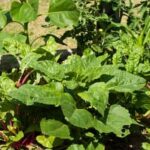Are you interested in starting your own vegetable garden but don’t know where to begin? Raised bed vegetable gardening for beginners is a great way to start growing your own fresh produce. In this comprehensive guide, we will cover everything from choosing the right location to harvesting and maintenance. Whether you have limited space or poor soil quality, raised bed gardening offers a practical solution for beginner gardeners.
One of the key advantages of raised bed gardening is the ability to control the quality of the soil, drainage, and overall environment for your plants. This makes it an ideal option for those with limited outdoor space or poor soil conditions.
Additionally, raised beds can provide better accessibility, making it easier for individuals with physical limitations to tend to their gardens. With the right knowledge and guidance, even beginners can successfully grow a variety of vegetables in a raised bed garden.
In this article, we will explore the essential factors to consider when starting a raised bed vegetable garden. From selecting the best location and vegetables for your garden to building and maintaining your raised bed, we will provide practical tips and advice to help beginners get started on their gardening journey.
If you’ve been considering delving into vegetable gardening but feel intimidated by traditional methods, raised bed gardening may be the perfect entry point for you. Let’s dive into the world of raised bed vegetable gardening for beginners and discover all that it has to offer.
Choosing the Right Location for Your Raised Bed Garden
When it comes to raised bed vegetable gardening for beginners, choosing the right location for your garden is crucial to the success of your plants. Here are some important factors to consider when selecting the perfect spot for your raised bed garden:
1. Sunlight: Choose a location that receives at least 6-8 hours of sunlight per day. Most vegetables thrive in full sun, so it’s important to place your raised bed in an area that gets plenty of light.
2. Water access: Make sure your raised bed garden is located near a water source for easy watering. Consider installing a drip irrigation system if you don’t have easy access to a water source.
3. Soil quality: Check the quality of the soil in the selected location. You’ll want to avoid areas with poor drainage or compacted soil. Raised beds allow you to control the quality of your soil, but it’s still important to choose a location with good soil structure.
4. Accessibility: Consider how accessible the location is for maintenance and harvesting. You’ll want a spot that is easy to reach and work around, especially if you plan on tending to your garden frequently.
By considering these factors, you can ensure that your raised bed vegetable garden will have the best chance of success and provide you with a bountiful harvest.
Remember, proper planning and consideration at this stage can save you time and effort in the long run, making your gardening experience more enjoyable and rewarding.
Selecting the Best Vegetables for Your Raised Bed Garden
When it comes to raised bed vegetable gardening for beginners, selecting the right vegetables is crucial for a successful and bountiful harvest. One of the main advantages of raised bed gardening is the ability to control the quality of the soil, which allows for a wide range of vegetables to thrive. With careful planning and consideration, you can maximize the productivity of your raised bed garden by choosing the best vegetables suited for this type of gardening.
First and foremost, it’s important to consider the size of your raised bed garden and select vegetables that are well-suited for compact spaces. In general, smaller root vegetables such as carrots, radishes, and beets are ideal for raised beds due to their shallow root systems.
Additionally, leafy greens like lettuce, spinach, and kale are excellent choices as they don’t require a lot of space to grow and can thrive in the nutrient-rich soil commonly found in raised beds.
Furthermore, when selecting vegetables for your raised bed garden, it’s beneficial to choose plants that are compatible with one another in terms of their growth habits and nutritional needs. For example, pairing tall-growing plants such as tomatoes or peppers with vining crops like cucumbers or beans can optimize space utilization while promoting healthy growth. Additionally, rotating crops each season can help prevent disease buildup in the soil and maintain soil fertility over time.
Building Your Raised Bed Garden
When it comes to building a raised bed garden for beginners, the materials and construction process are key elements to consider. The first step is to decide on the materials you will use for your raised bed.
The most common options include wood, stone, brick, or even recycled materials such as old tires or wine barrels. Wood is a popular choice due to its affordability and accessibility, but make sure to choose untreated, rot-resistant lumber to avoid any chemicals leaching into your soil.
Once you have chosen your materials, it’s time to start the construction process. Begin by determining the size and shape of your raised bed garden based on your available space and the types of vegetables you want to grow. Keep in mind that you should be able to reach the center of the bed from all sides without stepping on the soil to avoid compacting it.
After deciding on the size and shape, assemble the materials and start building your raised bed. If using wood, you can either nail or screw the pieces together or use corner brackets for added stability. For stone or brick beds, stack them securely and use mortar if necessary.
Make sure that all sides are level and secure before adding soil. Following these steps will ensure a sturdy and well-constructed raised bed vegetable gardening for beginners setup that will last for years to come.
Soil Preparation and Maintenance for Raised Bed Vegetable Gardening
When it comes to raised bed vegetable gardening for beginners, the importance of soil preparation cannot be overstated. The quality of the soil in your raised bed garden will directly impact the health and productivity of your vegetables. Here are some key steps to ensure that your soil is prepared and maintained properly:
1. Testing the Soil: Before you start planting, it’s essential to test the soil in your raised bed garden. You can use a home testing kit or send a sample to a local agricultural extension service for analysis. This will help you understand the pH level, nutrient content, and any potential deficiencies in your soil.
2. Amending the Soil: Based on the results of your soil test, you may need to amend the soil in your raised bed garden. This can include adding organic matter such as compost, peat moss, or aged manure to improve nutrient levels and drainage. It’s important to thoroughly mix these amendments into the existing soil before planting.
3. Mulching: Once your vegetables are planted, consider applying a layer of mulch to help retain moisture, suppress weed growth, and regulate soil temperature. Organic materials like straw, wood chips, or shredded leaves make excellent mulch for raised bed gardens.
4. Soil Maintenance: Throughout the growing season, it’s important to monitor the moisture levels in your raised bed garden and water as needed. You should also regularly inspect the plants for signs of nutrient deficiencies or pests, and address any issues promptly.
By following these soil preparation and maintenance guidelines for raised bed vegetable gardening, beginners can set themselves up for success and enjoy a bountiful harvest of fresh produce from their own backyard.
Watering and Fertilizing Your Raised Bed Garden
Watering and fertilizing are crucial aspects of raised bed vegetable gardening for beginners. Properly nourished plants will produce a bountiful harvest, while ensuring that they receive enough water will help them thrive.
Watering Your Raised Bed Garden
When it comes to watering your raised bed garden, it’s important to provide consistent moisture to your plants without overwatering them. One way to achieve this is through drip irrigation, which delivers a slow, steady supply of water directly to the roots of your plants. Alternatively, you can hand-water your garden with a hose or watering can, making sure to water deeply but infrequently to encourage deep root growth.
Fertilizing Your Raised Bed Garden
In raised bed vegetable gardening for beginners, using compost or well-balanced organic fertilizer is the key to providing essential nutrients to your plants. Before planting, mix in compost or organic fertilizer into the soil. Throughout the growing season, consider adding additional nutrients by side-dressing with compost or applying liquid organic fertilizer according to package instructions.
Additional Tips for Watering and Fertilizing
To help maintain moisture levels and reduce the need for frequent watering, consider adding a layer of mulch on top of the soil in your raised bed garden. This will also help suppress weeds and regulate soil temperature. Additionally, be sure to monitor the moisture levels in your raised beds regularly and adjust your watering routine as needed based on factors such as weather conditions and plant growth stage.
With proper attention to watering and fertilizing, beginners can enjoy a successful and productive raised bed vegetable garden. By following these tips, you can ensure that your plants have the nutrients and moisture they need to thrive and provide you with a plentiful harvest.
Pest and Weed Management in Raised Bed Gardens
One of the biggest challenges in raised bed vegetable gardening for beginners is managing pests and weeds. However, with the right approach, you can keep your plants healthy and thriving without the use of harmful chemicals. There are several organic methods you can use to prevent and control pests and weeds in your raised bed garden.
To manage pests, consider introducing beneficial insects such as ladybugs or lacewings, which feed on common garden pests like aphids and caterpillars. You can also plant companion flowers and herbs that repel pests, such as marigolds or basil. Additionally, regularly inspecting your plants for any signs of pest damage can help you catch issues early before they become a major problem.
When it comes to weed management, using mulch is an effective strategy. Mulching your raised bed garden with materials like straw or wood chips can prevent weeds from taking root and competing with your vegetables for nutrients. Hand weeding regularly is also important to remove any weeds that do manage to sprout up.
Another method for controlling both pests and weeds is practicing crop rotation. By changing the location of your vegetables each season, you can disrupt pest life cycles and reduce the build-up of soil-borne diseases. This simple practice can contribute significantly to the overall health of your raised bed garden.
Lastly, promoting a diverse ecosystem in your raised bed garden can help naturally regulate pest populations by attracting beneficial organisms like birds and pollinators. By creating a balanced environment, you can minimize the impact of pests without resorting to chemical pesticides.
This approach to pest and weed management aligns with the principles of organic gardening, which prioritize ecological balance and sustainability while producing healthy food. With these strategies in place, even beginners can successfully maintain a thriving raised bed vegetable garden without synthetic inputs.
| Pest & Weed Management Methods | Benefits |
|---|---|
| Introducing beneficial insects | Natural pest control without chemicals |
| Using mulch | Weed prevention without herbicides |
| Crop rotation | Reduced build-up of soil-borne diseases |
Tips for Successful Harvesting and Maintenance of Raised Bed Vegetable Gardens
Proper Harvesting Techniques
When it comes to harvesting your vegetables from a raised bed garden, it’s important to do so at the right time. Each type of vegetable will have different signs that indicate it is ready for harvest, such as color, size, and texture.
It’s best to research the specific vegetables you are growing to ensure you are picking them at their peak ripeness. Additionally, use proper tools such as garden shears or scissors to carefully harvest your produce without damaging the plant.
Maintenance Tasks
Regular maintenance is essential for the health and productivity of your raised bed vegetable garden. This includes tasks such as pruning, weeding, and monitoring for pests and diseases. Proper pruning techniques can promote better air circulation and encourage healthier growth in your plants. Weeding is important to prevent competition for nutrients and water, while monitoring for pests and diseases can help you address issues before they become a serious problem.
Seasonal Care
Different seasons call for different care in raised bed vegetable gardening. In the spring, prepare your soil by adding compost and other organic matter to enrich it with nutrients. Summer requires diligent watering due to increased heat and evaporation, while fall may involve planting cover crops to protect the soil over winter.
Winter care involves protecting your beds from freezing temperatures with covers or mulch. Understanding the seasonal care needs of your crops will help ensure a successful harvest year-round in your raised bed garden.
Conclusion
In conclusion, raised bed vegetable gardening offers numerous benefits and rewards for beginners. These elevated gardens provide better drainage, improved soil quality, and easier maintenance compared to traditional in-ground gardens. Additionally, raised beds can extend the growing season, making it possible to plant earlier in the spring and continue harvesting later into the fall.
One of the key benefits of raised bed vegetable gardening for beginners is the ability to start small and expand over time. This makes it less overwhelming for those who are new to gardening, allowing them to gradually learn and improve their skills as they become more comfortable with the process. Raised beds also provide better accessibility, making it easier for people with physical limitations to participate in gardening.
Furthermore, raised bed vegetable gardening allows beginners to have more control over soil quality, moisture levels, and pest management. This can result in increased yields and healthier plants. Overall, the rewards of raised bed vegetable gardening for beginners are plentiful – from enjoying fresh produce at home to experiencing the satisfaction of nurturing a garden from seed to harvest. With proper planning and care, raised bed vegetable gardening can be a fulfilling and fruitful experience for beginners.
Frequently Asked Questions
What Are Three Mistakes to Avoid When Gardening With Raised Beds?
When gardening with raised beds, it’s important to avoid the mistake of not preparing the soil properly. Make sure to mix in compost and other organic matter to create a rich growing environment.
Another mistake is overcrowding plants, which can lead to competition for nutrients and space. Lastly, failing to provide proper irrigation can be detrimental, so make sure your raised bed has adequate drainage.
What Vegetables Should Not Be Grown in a Raised Bed?
While many vegetables thrive in raised beds, there are some that may not do as well. Deep-rooted vegetables like carrots and parsnips may struggle in the shallow soil of a raised bed.
Additionally, vining plants such as watermelon or pumpkin may not have enough space to spread out and grow properly. It’s best to consider these factors before deciding what vegetables to plant in a raised bed.
What Vegetables Go Together in a Raised Bed?
Certain vegetables complement each other well when planted together in a raised bed. For example, planting tomatoes with basil can help repel pests and improve the flavor of both plants. Carrots and radishes are another good combination since they have different root depths and won’t compete for space underground.
Additionally, planting lettuce around taller plants can provide shade and protection from the sun’s heat. These are just a few examples of vegetables that go well together in a raised bed garden.

If you’re looking to get into vegetable gardening, or are just looking for some tips on how to make your current garden better, then you’ve come to the right place! My name is Ethel and I have been gardening for years. In this blog, I’m going to share with you some of my best tips on how to create a successful vegetable garden.





